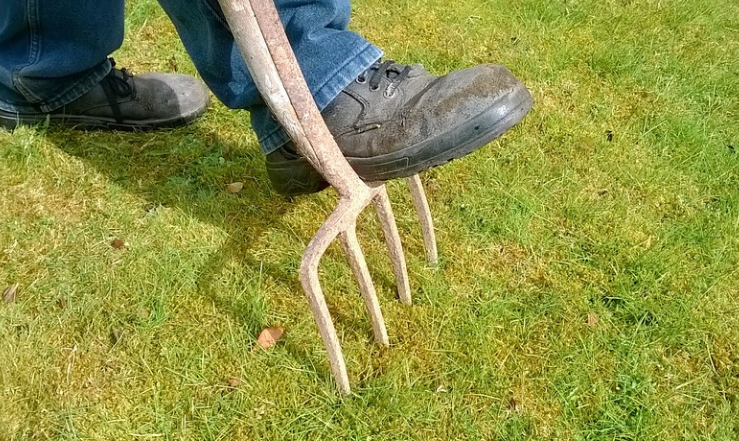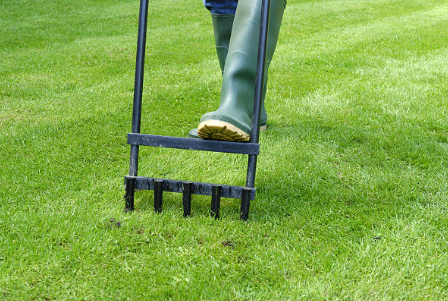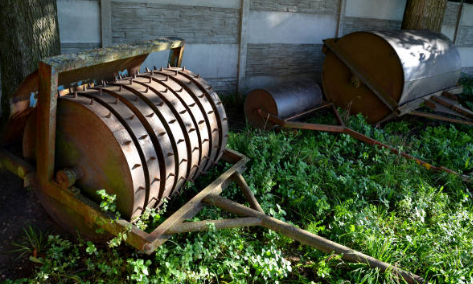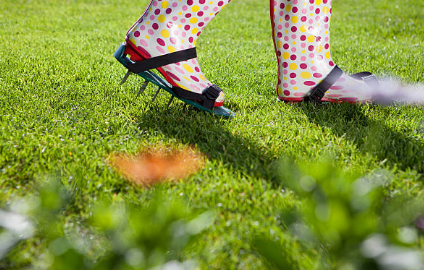
Let soil plugs or extra soil dry where they land after you’ve finished aerating your lawn. When it rains or when you mow the following time, they’ll crumble and add healthy soil and organic matter to the top layer of your lawn. Continue reading, you will learn more about aerating lawns.
Table of Contents
What is Lawn Aeration?
By removing soil plugs from the turf, the process of aeration involves exposing your soil to the air. It’s a typical component of spring lawn care.
As a result, the soil develops hollows that let water and nutrients pass through, improving the quality and health of the grass over time and producing stronger roots. Roots that are in better health can withstand the summertime heat and droughts.
What to Do After Aerating Lawn?
Be aware of your objectives prior to lawn aeration. Your objective might be to make your grass dense and fill in any bald or thin spots. Alternatively, you might want to improve the health of your current grass while reducing the number of weeds in your yard.
A strategy for putting your goals into practice can be developed once you are aware of your objectives and the products you will require. The following six tasks are ones you might want to complete after aerating your lawn. When creating your after-aeration plan, keep in mind to only use the techniques that will help you achieve your objectives and to take into account the instructions on any products you have bought.
Break Down Cores (Or Allow Them to Break Down)
You want the cores produced by an aerator to disintegrate as soon as possible. You can collect them, grind them up, and then redistribute this to the lawn to hasten the process. Alternatively, you can use a rake to help break them up slightly.
I wait for the cores to degrade while leaving them in their current state. This enables you to disturb the lawn the least and, in my opinion, produces the best results. Who could argue with less work and better results even though it may not be the prettiest? The cores should naturally decompose after about a week of consistent watering.
Apply a Herbicide
Pre-emergent herbicides are typically applied after aeration. For best results, use these as soon as spring arrives. They can assist in getting rid of weed seeds that are buried in the soil after aeration, preventing them from growing into a problem.
Allow Your Lawn to Rest
You should give your lawn some time to recover after aerating. This implies that you should wait until your lawn requires mowing. The majority of the time, this entails temporarily allowing your lawn to reach a height of 3.5″. In order to avoid compaction, traffic on the lawn should be restricted for a week or two.

Water Your Lawn
Watering your lawn after aeration helps the ground “settle”. Watering needs to be done sparingly, lasting no longer than 15 to 20 minutes, or however long your typical daily watering schedule is. To stop water from condensing inside your lawn’s new pores after aeration, you should refrain from deep watering for the first few days. If you intend to seed or fertilize your lawn, you should do so after taking this action.
Apply Fertilizer to Your Lawn
Regardless of the aeration technique, you select, fertilizing your lawn is a great thing to do after aeration. While fertilizing and overseeding can be combined, applying an herbicide at the same time is not recommended.
Overseed If Conditions Are Right
Lawn overseeding requires some thought and consideration. Make sure the weather is appropriate by keeping an eye on the local forecast. It is a good idea to oversee immediately following aerating and just before watering if they are and overseeding supports your objectives.
What Are the Benefits of Lawn Aeration?
Aeration is particularly useful for lawns that undergo a lot of foot traffic. The soil becomes more compacted as a lawn is used more frequently.
The air-filled spaces in the soil are significantly reduced as a result.
Compaction can have a detrimental impact on root growth because it reduces the airflow within the soil. To expand and absorb water and nutrients, roots require oxygen from the air.
How Aeration Improves Your Lawn?
- Aeration increases oxygen, water, and nutrient movement through the soil.
- Stronger roots are made possible by aeration.
- Better irrigation and rainfall absorption are made possible by aeration.
- A layer of topsoil is created beneath the grass thanks to aeration.
- Runoff from fertilizers and pesticides is reduced by aeration.
- Air movement prevents the buildup of thatch.
Does My Lawn Need Aeration?
Not every lawn requires aerating.
Remove a section of your lawn that is six inches deep to determine whether you need to aerate. When grassroots only penetrate one to two inches into the soil, it might be too compacted.
Aeration would be highly advantageous in that situation for your lawn.
Why Aerating Helps Lawns?
To become thick, deep, and strong, the grassroots require nutrients, water, and air. Even a small amount of soil compaction prevents the flow of the necessary elements for thicker, healthier turf growth. Aeration makes holes deep into the soil to break up compaction and allow air, water, and nutrients to reach grass roots. Just a thin layer of compacted soil, about 1/4 to 1/2 inch thick, can significantly affect the health and beauty of your lawn1.

Compacted soil deprives lawn grasses of their essential nutrients, which causes them to struggle in challenging conditions like heat and low rainfall and lose their vibrant, healthy color. Because of a lack of oxygen, water, and nutrients that are just inches away, grass gradually becomes thinner and eventually completely disappears. Even one aeration session can provide the necessary opening for these elements to make their mark and return your lawn to its upward trajectory.
When Lawns Need Aeration?
Although it might not seem possible, compacting your lawn is much simpler than you might realize. Even outdoor entertaining or yard play by children and pets can compact all or a portion of your lawn. The most obvious offenders are vehicles or small equipment driven on lawns. Your lawn will likely need annual aeration if heavy clay soil is the norm where you live in order to prevent it from getting flimsy and weak.
Despite being two distinct tasks, dethatching and aerating frequently go together. Thatch is the layer of organic matter in various stages of decomposition that forms between the soil and the grass at the lawn’s surface. Thatch acts as a compaction when it is more than half an inch thick, obstructing the flow of air, water, and nutrients that grasses require. More thatch is produced by aggressive spreading grasses than many other grass types, including Bermudagrass in the south and Kentucky bluegrass in northern lawns. Aeration aids in penetration and lowers thatch buildup, or prepares it for dethatching.
You might have compaction issues if your grass frequently appears stressed, your soil feels hard to the touch, or rainwater pools up where it used to be absorbed. Confirm your suspicions with a simple “screwdriver test.” Make a hand indentation in the soil of your lawn with a regular screwdriver. It ought to fit in without too much trouble. Aeration can help if you encounter resistance because your soil is compacted.
When to Aerate Your Lawn?
Aerating your lawn is best done during or just before the time when your grasses are at their peak for natural growth, just like with most larger lawn projects, like sowing grass seed. Although aeration is beneficial for lawns, if done at the wrong time, it can stress the grass. Never aerate a lawn that is not in use.
The best times to aerate cool-season grasses, which are common in northern lawns, are early fall or early spring. Late spring or very early summer are the ideal times to aerate lawns with warm-season grasses, which are typical of southern lawns. Grasses recover quickly and fill in spaces where aerator equipment exposes soil when aeration coincides with active growth.
When the soil is moist from irrigation or rain the day before, aerating is easiest for you (or the person operating the equipment) and your lawn. Moisture makes the aeration of excessively dry soil easier. Wait a few days before aerating excessively soggy lawns.
How to Aerate Your Lawn?
Aerating equipment comes in three main types, from small manual versions to larger tractor-like or pull-behind machinery:
- Spike aerators simply poke a hole down into the soil with a solid, spike-like tine. Some homeowners wear spiked aerator “sandals” strapped to their shoes to aerate as they do yard work. Although they can be beneficial in small doses, spike machines can exacerbate compaction by compacting soil around the holes.1
- Slicing aerators have rotating blades that cut or slice through grass and thatch down into the soil. Slicing aerators, like spike aerators, do not remove soil from the ground; instead, they open up passageways for air, water, and nutrients without adding to soil compaction.

- Core or plug aerators, typically preferred by lawn professionals, use rows of hollow tines that remove plugs of soil from your lawn and deposit them on top, where they break down. Depending on the machine used, different plug sizes and holes with different widths and depths result.
Aerating can be done either professionally by a lawn service or by you on your own. Aerator machines are frequently rented from lawn and garden supply stores and equipment rental businesses, and the models you select will come with basic operating instructions. Aerating involves moving back and forth across your lawn, much like when you mow. Pay close attention to any areas that have a history of problems, such as pet runs or backyard baseball diamonds. To help ensure ideal coverage and benefits, make several passes in various directions.
How to Treat Your Lawn After Aerating?
After aeration, the best way to care for your lawn is to let the soil plugs naturally decompose, establish a regular watering schedule, fertilize with a high-nitrogen fertilizer, and either overseed your lawn with new grass or use a pre-emergent herbicide to prevent weeds from sprouting.
Should I Water My Lawn After Aerating?
Yes, unless it is raining, you should water your lawn after aeration. The grass needs to be watered even if rain is predicted for the day or night after aeration. If rain is anticipated within the next 24 hours, water the plant sparingly right after aeration. It would be undesirable for the newly created water-draining pores in your lawn to become blocked with water. Additionally, you don’t want the ground to become so soft that even light foot traffic compacts and settles your lawn.
Aerating Your Lawn at Specific Times of the Year
There are seasons of the year when one option or set of objectives will be preferable to the others, even though the number of things you could do after aerating your lawn won’t change.
What to Do After Aerating a Lawn in Spring?
In any climate, spring is the best time to aerate followed by the application of a pre-emergent herbicide. Pre-emergent herbicides used after aeration can help your grass get a jump on the season if you are having serious weed control problems and you did not overseed after frost the previous year. One of the few things you can do to thicken your lawn without adding more grass seed is this.

In warmer climates, this is a good time to oversee your lawn if you are not applying an herbicide in the spring. In contrast, fertilizer applied in the spring might be more effective than fertilizer applied in the fall, in colder climates.
What to Do After Aerating a Lawn in Fall?
If you want to oversee your lawn and have that seed sprout and establish itself in the same year, aeration in the early fall is your best bet. If it is early fall, you can do this in both warm and cold climates. Late fall is a good time to aerate, but you shouldn’t overseed until temperatures are consistently below 35F to avoid the seed’s germination.
What Are the Additional Signs You Need Aeration?
- Your lawn sees a lot of traffic.
- More than a half inch of thatch can be found on your lawn.
- Your soil is made of thick clay.
If the soil in your lawn is not prone to compaction, it will probably grow normally without aeration.
Compacted soil is frequently made more pliable by natural forces like earthworm activity and winter freeze-thaw cycles. Do not aerate your lawn during the first year your lawn is newly seeded or sodded.
Conclusion on Do After Aerating Lawn
Your lawn will more readily absorb nutrients and water once it has been properly aerated. The grass will grow roots that are healthier and have much more vibrant blades. Following aeration, you should fertilize your lawn, oversee it, water your lawn to nourish the grassroots and let any soil plugs naturally decompose.